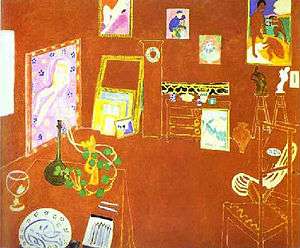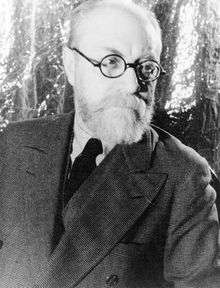L'Atelier Rouge

L'Atelier Rouge, also known as The Red Studio, is a painting by Henri Matisse from 1911, in the collection of The Museum of Modern Art, New York City.[1][2]
The atelier (studio) is the one that Matisse had built for himself in 1909, although it was in actuality white. Matisse's own works are carefully arranged in the background. According to the Museum, "Angled lines suggest depth, and the blue-green light of the window intensifies the sense of interior space, but the expanse of red flattens the image ... The entire composition is clustered around the enigmatic axis of the grandfather clock, a flat rectangle whose face has no hands. Time is suspended in this magical space. On the foreground table, an open box of crayons, perhaps a symbolic stand-in for the artist, invites us into the room. But the studio itself, defined by ethereal lines and subtle spatial discontinuities, remains Matisse's private universe."[1]
In 2004 it came in at No.5 of a poll of 500 art experts voting for the most influential modern art work of all time, along with works by Pablo Picasso, Marcel Duchamp and Andy Warhol. [3]
References
- 1 2 MoMA collection
- ↑ Matisse and "The Red Studio", Robert F. Reiff, Art Journal, Vol. 30, No. 2 (Winter, 1970-1971), pp. 144-147, retrieved online December 25, 2007
- ↑ 1 December 2004 "Duchamp's urinal tops art survey" BBC News
